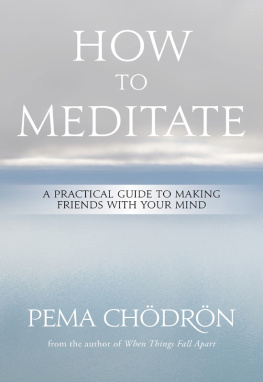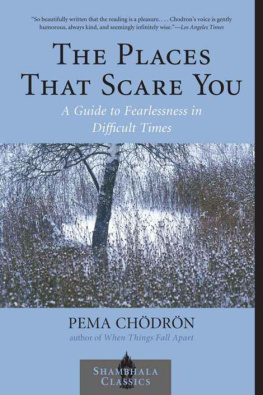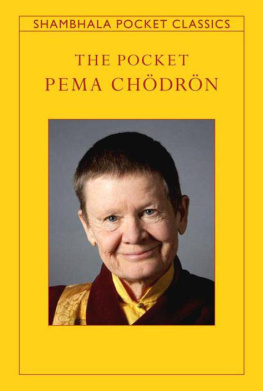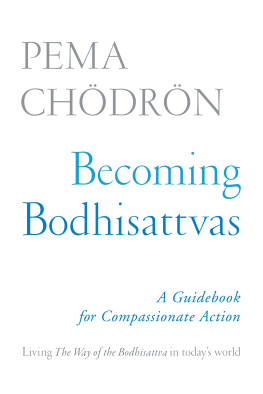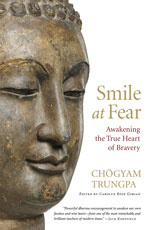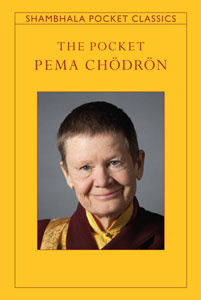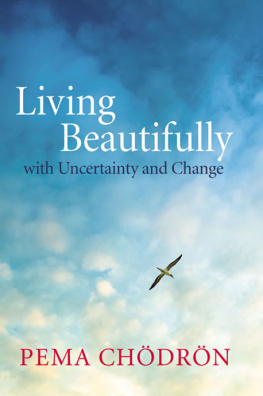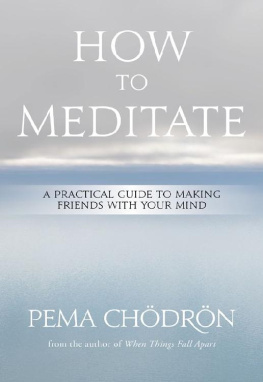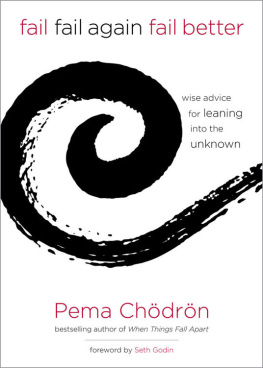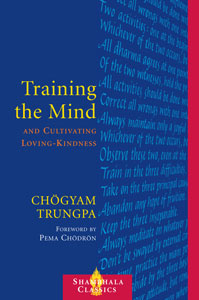HOW
TO
MEDITATE
A PRACTICAL GUIDE TO MAKING
FRIENDS WITH YOUR MIND
PEMA CHDRN

Meditation is simply training our state of being so that our mind and body can be synchronized. Through the practice of meditation, we can learn to be without deception, to be fully genuine and alive.
CHGYAM TRUNGPA RINPOCHE
Our life is an endless journey: the practice of meditation allows us to experience all the textures of the roadway, which is what the journey is all about.
CHGYAM TRUNGPA RINPOCHE
CONTENTS
INTRODUCTION
CHOOSING TO LIVE WHOLEHEARTEDLY
The principle of nowness is very important to any effort to establish an enlightened society. You may wonder what the best approach is to helping society and how you can know that what you are doing is authentic and good. The only answer is nowness. The way to relax, or rest the mind in nowness, is through the practice of meditation. In meditation you take an unbiased approach. You let things be as they are, without judgment, and in that way you yourself learn to be.
CHGYAM TRUNGPA RINPOCHE
T he mind is very wild. The human experience is full of unpredictability and paradox, joys and sorrows, successes and failures. We cant escape any of these experiences in the vast terrain of our existence. It is part of what makes life grandand it is also why our minds take us on such a crazy ride. If we can train ourselves through meditation to be more open and more accepting toward the wild arc of our experience, if we can lean into the difficulties of life and the ride of our minds, we can become more settled and relaxed amid whatever life brings us.
There are numerous ways to work with the mind. One of the most effective ways is through the tool of sitting meditation. Sitting meditation opens us to each and every moment of our life. Each moment is totally unique and unknown. Our mental world is seemingly predictable and graspable. We believe that thinking through all the events and to-dos of our life will provide us with ground and security. But its all a fantasy, and this very moment, free of conceptual overlay, is completely unique. It is absolutely unknown. Weve never experienced this very moment before, and the next moment will not be the same as the one we are in now. Meditation teaches us how to relate to life directly, so that we can truly experience the present moment, free from conceptual overlay.
If we look at the dharmain other words, the teachings of the Buddha, the truth of what iswe see that through the practice of meditation the intention is to remove suffering. Maybe thats why so many people are attracted to meditation, because generally people dont find themselves sitting in the meditation posture unless they have something thats bothering them. But the Buddhist teachings are not only about removing the symptoms of suffering, theyre about actually removing the cause, or the root, of suffering. The Buddha said, I teach only one thing: suffering and the cessation of suffering.
In this book, I want to emphasize that the root of suffering is mindour minds. And also, the root of happiness is our mind. The sage Shantideva, in the Bodhicaryavatara, in talking about the subject of suffering, offered a famous analogy for how we try to alleviate our suffering. Hes said that if you walk on the earth and its hurting your feet, you might want to cover all the earth with hides of leather, so that youd never have to suffer from the pain of the ground. But where could such an amount of leather be found? Rather, you could simply wrap a bit of leather around your feet, and then its as if the whole world is covered with leather and youre always protected.
In other words, you could endlessly try to have suffering cease by dealing with outer circumstancesand thats usually what all of us do. It is the usual approach; you just try to solve the outer problem again and again and again. But the Buddha said something quite revolutionary, which most of us dont really buy: if you work with your mind, you will alleviate all the suffering that seems to come from the outside. When something is bothering youa person is bugging you, a situation is irritating you, or physical pain is troubling youyou must work with your mind, and that is done through meditation. Working with our minds is the only means through which well actually begin to feel happy and contented with the world that we live in.
Theres an important distinction that needs to be made about the word suffering. When the Buddha said, The only thing I teach is suffering and the cessation of suffering, he used the word dukkha for suffering. Dukkha is different than pain. Pain is an inevitable part of human life, as is pleasure. Pain and pleasure alternate, and theyre just part and parcel of anybody who has a body and a mind and is born into this world.
The Buddha didnt say that, I teach only one thing: pain and the cessation of pain. He said pain isyou have to grow up to the fact, mature to the fact, relax to the fact that there will be pain in your life. Youre not going to reach the point where, if someone you love dies, you wont feel grief. Youre not going to reach the point where if you fall down a flight of stairs youre not bruised. As you age, your back might hurt and your knees might ache. These things and many others could happen.
Even the most advanced meditator has moods. The quality of energy moving through peoplethe heavier, more oppressive energies that we call depression, or fear, or anxietythese kinds of mood energies run through all beings, just as the weather changes from day to day. Our internal weather is shifting and changing all the time, whether were fully enlightened or not. The question then becomes, how do we work with these shifting energies? Do we need to completely identify with them and get carried away and dragged down by them?
The word dukkha is also translated as dissatisfaction, or never satisfied. Dukkha is kept alive by being continually dissatisfied with the reality of the human condition, which means being continually dissatisfied with the fact that pleasant and unpleasant situations are part and parcel of life. Theres a strong tendency on the part of all living beings to want the pleasant, agreeable, comfortable, secure feelings to be all-pervasive. If theres pain in any formif theres anything disagreeable, uncomfortable, or insecurewe want to run away from that and avoid it. This is why we turn to meditation.
WHY MEDITATE?
We do not meditate in order to be comfortable. In other words, we dont meditate in order to always, all the time, feel good. I imagine shockwaves are passing through you as you read this, because so many people come to meditation to simply feel better. However, the purpose of meditation is not to feel bad, youll be glad to know. Rather, meditation gives us the opportunity to have an open, compassionate attentiveness to whatever is going on. The meditative space is like the big skyspacious, vast enough to accommodate anything that arises.
In meditation, our thoughts and emotions can become like clouds that dwell and pass away. Good and comfortable, pleasing and difficult and painfulall of this comes and goes. So the essence of meditation is training in something that is quite radical and definitely not the habitual pattern of the species: And that is to stay with ourselves no matter what is happening, without putting labels of good and bad, right and wrong, pure and impure, on top of our experience.

